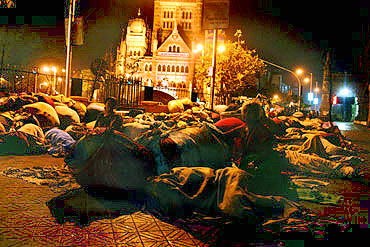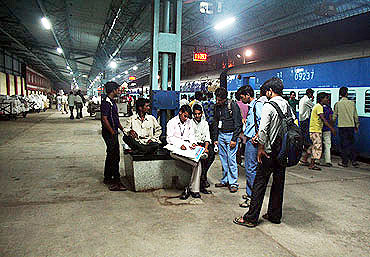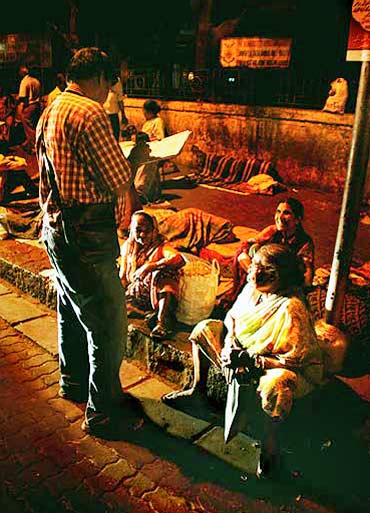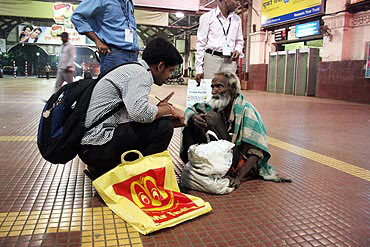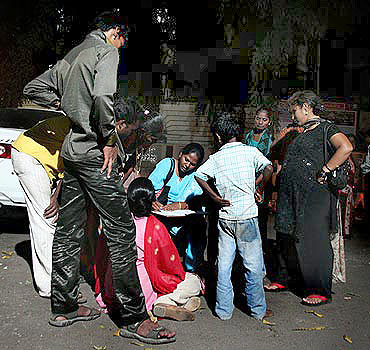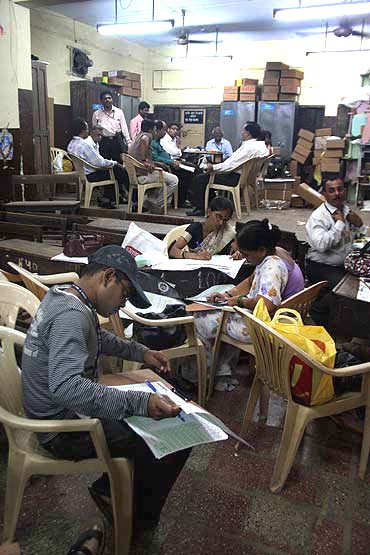 | « Back to article | Print this article |
A night spent with Mumbai's homeless
Rediff.com's Uttam Ghosh slung a camera on his shoulders and joined a team of census officials with a tough job: enumerating the homeless in Mumbai.
We see them everyday, and almost never spare a second glance. The men, women and children who eat, sleep and wake up on our pavements, under our bridges and on deserted platforms of our railway stations.
Recently, census officials in Mumbai took to the streets to gather details about the thousands of homeless people living on the fringes of society in the city.
Click on NEXT for more...
A night spent with Mumbai's homeless
There is no official count of the number of homeless people in the teeming metropolis, as thousands of migrants continue to pour in everyday, dreaming of a better life in the City of Gold.
In the dead of the night, census officials walked along the roads of south Mumbai, talking to the scores of people lining the pavements.
The homeless were asked questions about their age, jobs, place of origin etc.
Click on NEXT for more...
A night spent with Mumbai's homeless
The people sleeping in front of the awe-inspiring Chhattrapati Shivaji Terminus told the census officials that they come from all over Maharashtra. "Our jan ganana (counting) has already been done," they said.
While an old woman asked the census enumerator whether she will get a new home after the exercise, an elderly person told them that he had been living on a platform at CST station for nearly three decades.
Click on NEXT for more...
A night spent with Mumbai's homeless
The exercise was carried out in the night as it would be difficult to locate these people in the daytime, when they would be out on their daily chores and assorted jobs.
The census officials covered nearly 700 spots through the night for the 15th National Census.
The Brihanmumbai Municipal Corporation carried out the exercise between 10 pm and 4 am.
Click on NEXT for more...
A night spent with Mumbai's homeless
According to officials, the maximum number of homeless population was found in the relatively affluent south Mumbai.
Despite living in easily the wealthiest piece of real estate in the entire country, these people don't have access to the basic amenities of life, including clean water, food or a roof over their heads.
But the census exercise works as a great equaliser, enveloping the richest corporates to the poorest street-dwellers in the pages of its official sheets.
Click on NEXT for more...
A night spent with Mumbai's homeless
"The enumerators had prepared a list of locations where the homeless people spend the night. They were asked all types of questions, from personal details to educational qualification to sources of income," said a BMC official.
"The exercise went off smoothly. Every single team, which had three-four enumerators, one supervisor and one police constable, covered at least four spots," he added.
Click on NEXT for more...
A night spent with Mumbai's homeless
The last phase of the census, which started on February 9 and ended on February 28, included head counting and population enumeration.
In this phase, the enumerators collected data on demography, economic activity, literacy and education, housing and household amenities, urbanisation, fertility and mortality, caste, tribe, language, religion and migration of residents.
Click on NEXT for more...
A night spent with Mumbai's homeless
After conducting the all-night survey, the group come back to the ward office to collate the data at 6 am.
The group of census enumerators, mostly BMC employees, also includes graduates, doctors, engineers, teachers, bus conductors and sweepers. Some teachers have also volunteered their services.
With inputs from PTI
